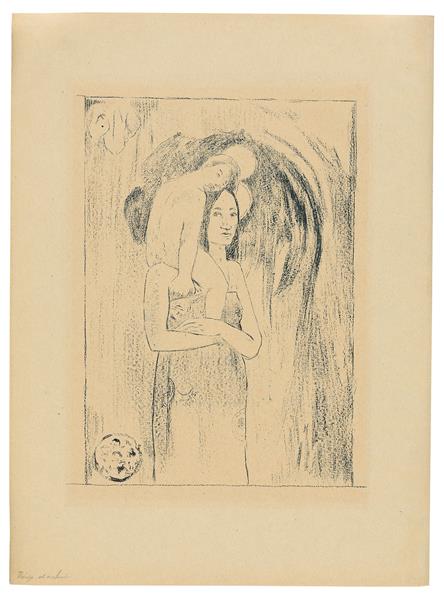Beskrivelse
Arbejdet "Ia Orana María" (Ave Maria), oprettet i 1895 af Paul Gauguin, står som et resonant vidnesbyrd om passagen af passagen af kunstmester af Tahiti og på samme tid en kontemplativ og symbolsk udforskning af polynesisk spiritualitet og kultur. Med dette arbejde turde Gauguin ud over den overfladiske repræsentation og fordyber sig i essensen af sine spørgsmål og bevarede sin ambition om at afsløre, hvad han betragtede som den "primitive ånd" af menneskeheden.
Sammensætningen af maleriet har en næsten arkitektonisk karakter, der holder på en baggrund af frodig vegetation og varme toner, der kendetegner det tahitiske miljø. I midten bærer figuren af Jomfru Maria, repræsenteret med et roligt ansigt, den fødte af en farverig glorie, der fremhæver dens guddommelighed. Hans hud har en brun nuance, der afspejler tidens kulturelle fusion, hvor den første brug af en ikke -eurocentrisk farve i religiøst maleri føles som en påstand.
Foran hende, en tahitisk ung kvinde, der står og med en traditionel lokal påklædning, ser hun ud til at gå til Jomfruen med en gestus af ærbødighed. Delikatessen i hans figur står i kontrast til robustheden af blade og blomster, der omgiver det, og manifesterer et drama, der fremhæver forholdet mellem guddommelighed og menneskehed. Den unge kvindes kontemplative holdning, der synes i en tilstand af glæde eller meditation, skaber en næsten åndelig forbindelse mellem begge figurer, der markerer Gauguins intention om at fusionere traditioner og overbevisninger.
Brugen af farve i "Ia Orana María" er grundlæggende og afslører Gauguins mestring for at manipulere lys og skygge. Den pulserende palet inkluderer intense og dybe blå grønne toner, der giver energi til det naturlige miljø. Blomsterne i bunden, i intense og muntre farver, tilføjer en luft af ferie til maleriet, mens de understreger rigdommen i det tahitiske landskab. Denne kromatiske tilgang understreger ikke kun stedets skønhed, men skaber også et næsten drømmeagtige miljø, der gennemsyrer hele værket.
Symbolikken i "Ia Orana María" er lige så betydelig. Tilstedeværelsen af den religiøse figur i en så eksotisk og fjern kontekst af europæiske miljøer inviterer refleksion over universaliteten af tro og kulturel mangfoldighed. Gauguin udfordrer gennem sin kunst det vestlige kunsthierarki og præsenterer en interkulturel dialog, der overskrider geografiske grænser.
Arbejdet, som andre fra Gauguin, lider ofte af dets fortolkning med hensyn til primitivisme, hvor den tahitiske kultur har en tendens til at eksotisere. Imidlertid inviterer "Ia Orana María" dig til at opleve en dybere og mere følelsesladet forbindelse med dens indhold, hvor enkelheden af bevægelser og pragt af farve hvisker historier om tro, håb og samfund.
Endelig er "Ia Orana María" ikke kun et vidnesbyrd om Gauguins kunstneriske evne, men det er en afspejling af et historisk øjeblik i kunsten, hvor kulturelle grænser begyndte at sløre. Arbejdet indkapsler kunstnerens ønske om at finde en sandhed, en forbindelse med den primitive og hans kontinuerlige indsats for at rejse ud over de etablerede konventioner. Dermed efterlod Gauguin et uudsletteligt brand i moderne kunst og lod os alle skimte en verden, hvor spiritualitet og menneskehed sameksisterer i harmoni.
KUADROS ©, en berømt maling på din væg.
Håndlavede olie -malerier med kvaliteten af professionelle kunstnere og den karakteristiske segl af KUADROS ©.
Billeder reproduktionstjeneste med tilfredshedsgaranti. Hvis du ikke er helt tilfreds med kopien af dit maleri, refunderer vi dine penge 100%.

